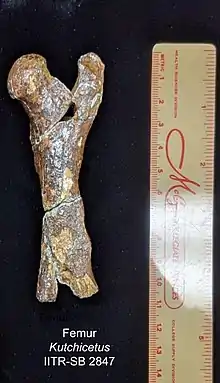| Kutchicetus Temporal range: Middle Eocene, | |
|---|---|
 | |
| Reconstruction of Kutchicetus | |
| Scientific classification | |
| Domain: | Eukaryota |
| Kingdom: | Animalia |
| Phylum: | Chordata |
| Class: | Mammalia |
| Order: | Artiodactyla |
| Infraorder: | Cetacea |
| Family: | †Remingtonocetidae |
| Genus: | †Kutchicetus Bajpai & Thewissen 2000 |
| Species: | †K. minimus |
| Binomial name | |
| †Kutchicetus minimus | |
Kutchicetus is an extinct genus of early whale of the family Remingtonocetidae that lived during Early-Middle Eocene (Lutetian and Ypresian) in what is now the coastal border of Pakistan and India (23°42′N 68°42′E / 23.7°N 68.7°E, paleocoordinates 6°00′N 61°48′E / 6.0°N 61.8°E).[1][2] It is closely related to Andrewsiphius with which it was synonymized by Gingerich et al. 2001.[3] Thewissen & Bajpai 2009 proposed a new clade, Andrewsiphiinae, for the two species. Later authors,[4] however, still accept both as separate genera.
Kutchicetus is smaller than other remingtonocetids, and probably is the smallest Eocene cetacean. With its extremely narrow snout, it resembles Remingtonocetus and Dalanistes, but its strong tail distinguishes it from both Remingtonocetus and Andrewsiphius. Its limbs were short.[5]

Kutchicetus' vertebral formula is 7, 15, 8, 4, 20–25. Its four fused sacral vertebrae were probably articulated to the hip bone and the numerous tail vertebrae were robust and elongated in contrast to its short and relatively gracile limb bones. This morphology suggests that the tail played an important role in its locomotion, yet the proportions of the caudal-most vertebrae indicates Kutchicetus did not have flukes.[6]
Kutchicetus vertebral proportions are unlike those of any other cetaceans but similar to those of some land-living or semi-aquatic mammals, such as Pachyaena and otters. Kutchicetus' limbs and sacrum were probably weight-bearing and it probably swam using undulatory movements like modern otters and most likely Ambulocetus.

This mode of locomotion represents a transitional stage in whale evolution.[6][7]
See also
Notes
- ↑ Kutchicetus in the Paleobiology Database. Retrieved 9 July 2013.
- ↑ Godhatad (Eocene of India) in the Paleobiology Database. Retrieved 9 July 2013.
- ↑ Gingerich et al. 2001, p. 288
- ↑ E.g., Uhen 2010, p. 203
- ↑ Bajpai & Thewissen 2000, p. 1478
- 1 2 Bajpai & Thewissen 2000, pp. 1480–1
- ↑ Marx, Felix; Lambert, Oliver; Uhen, Mark (2016). Cetacean Paleobiology (TOPA Topics in Paleobiology) (1st ed.). Wiley-Blackwell. ISBN 978-1118561270.
References
- Bajpai, Sunil; Thewissen, J. G. M. (2000). "A new, diminutive Eocene whale from Kachchh (Gujarat, India) and its implications for locomotor evolution" (PDF). Current Science. 79 (10): 1478–82. Retrieved 9 July 2013.
- Gingerich, P. D.; Ul-Haq, M.; Khan, I. H.; Zalmout, I. S. (2001). "Eocene stratrigraphy and archaeocete whales (Mammalia, Cetacea) of Drug Lahar in the eastern Sulaiman range, Balochistan (Pakistan)". Contributions from the Museum of Paleontology, University of Michigan. 30 (11): 269–319. hdl:2027.42/48661.
- Thewissen, J.G.M.; Bajpai, Sunil (2009). "New Skeletal Material of Andrewsiphius and Kutchicetus, Two Eocene Cetaceans from India". Journal of Paleontology. 83 (5): 635–63. doi:10.1666/08-045.1. OCLC 4908550552. S2CID 86090504.
- Uhen, Mark D. (2010). "The Origin(s) of Whales" (PDF). Annual Review of Earth and Planetary Sciences. 38 (1): 189–219. Bibcode:2010AREPS..38..189U. doi:10.1146/annurev-earth-040809-152453. Retrieved 25 July 2013.